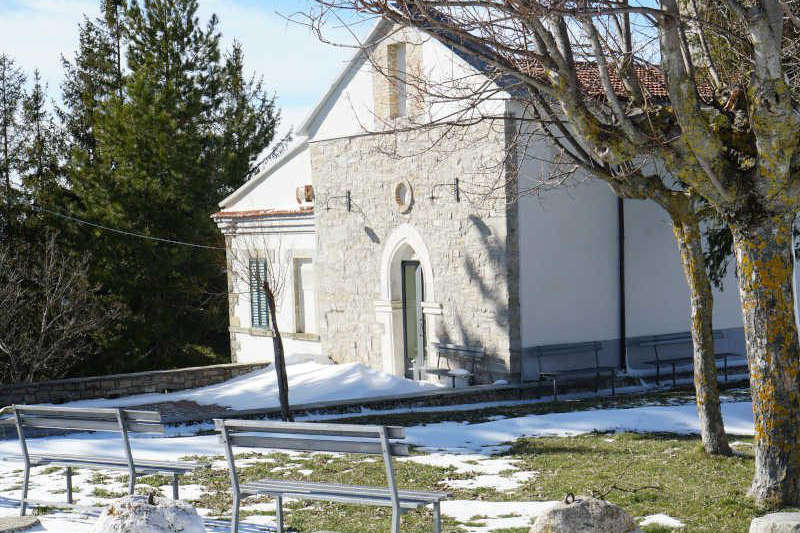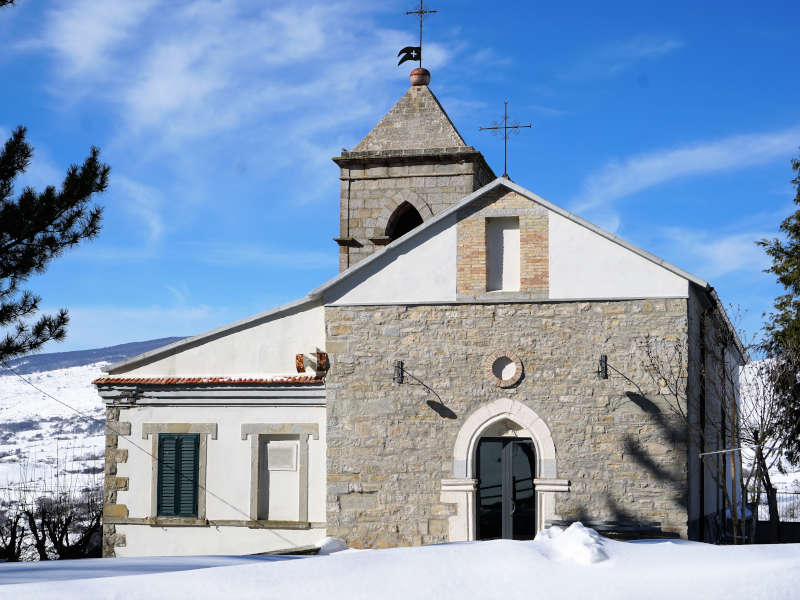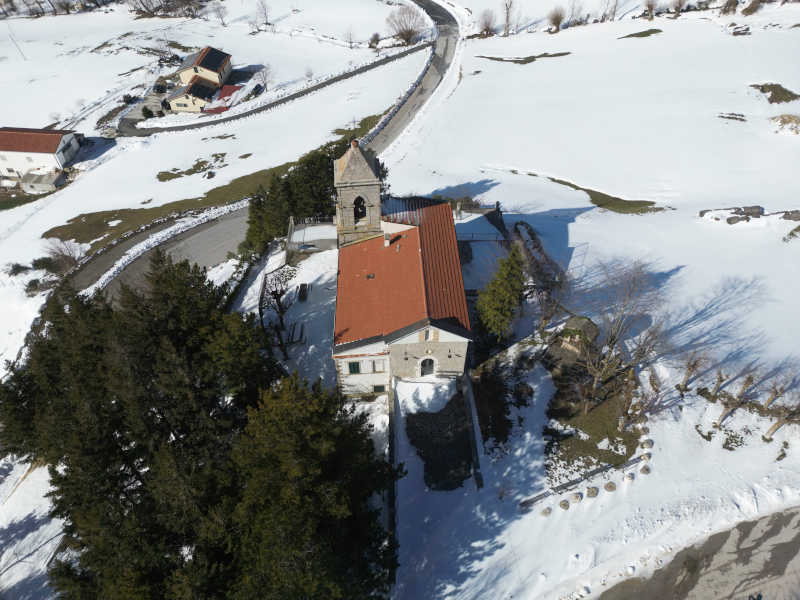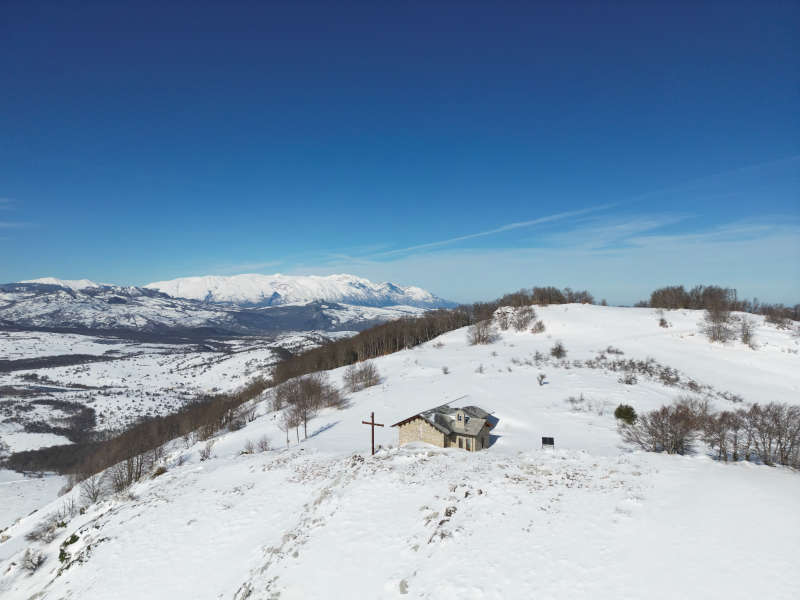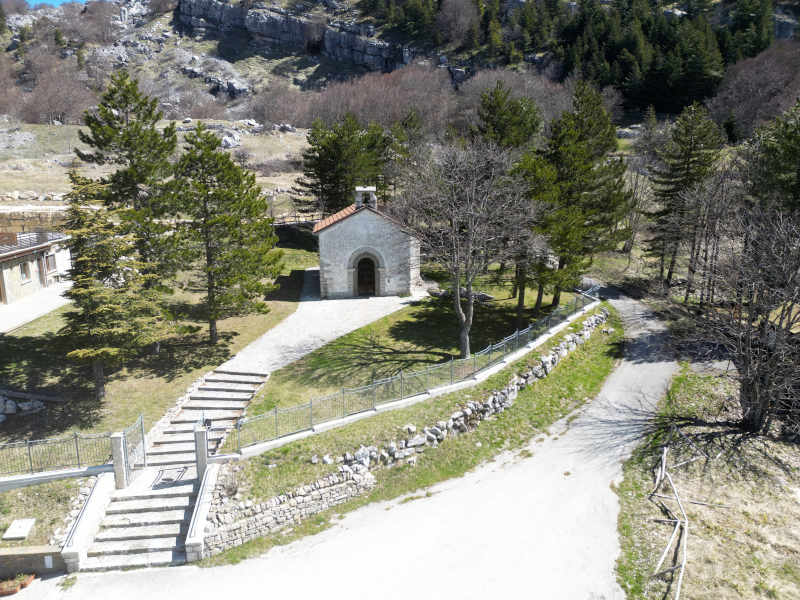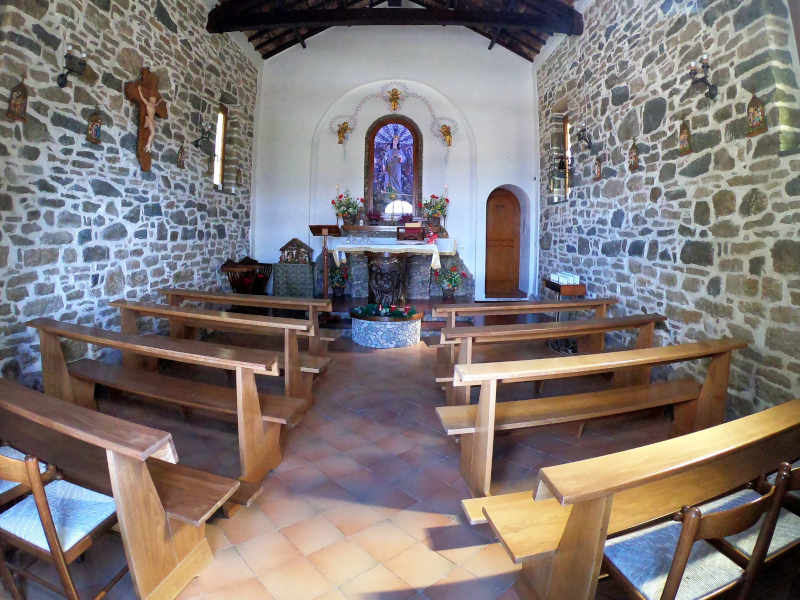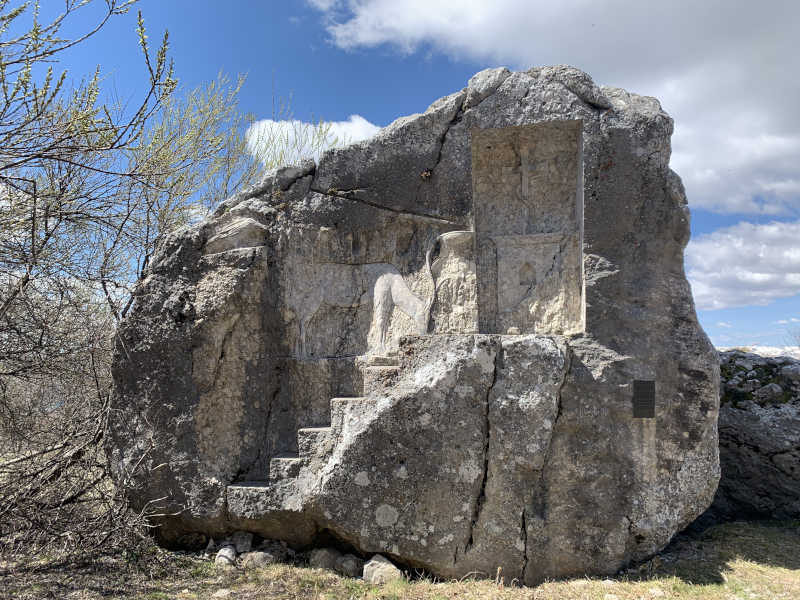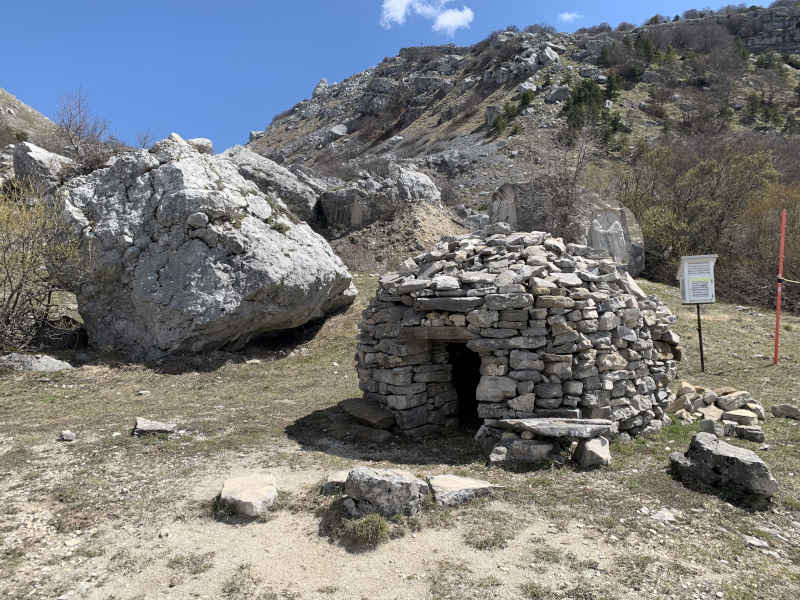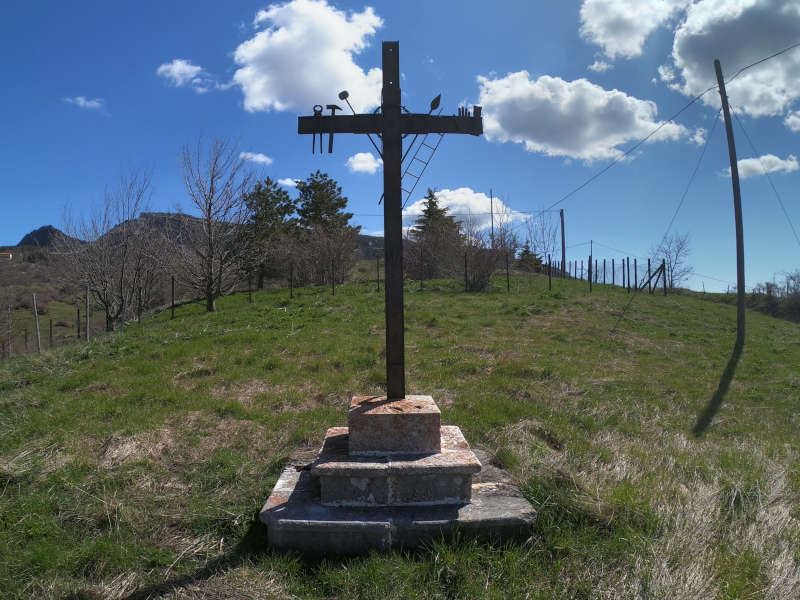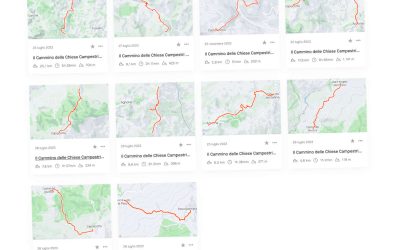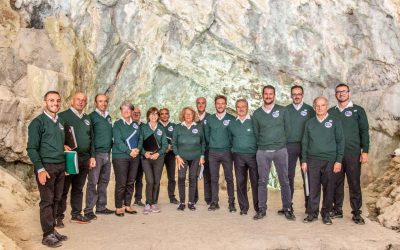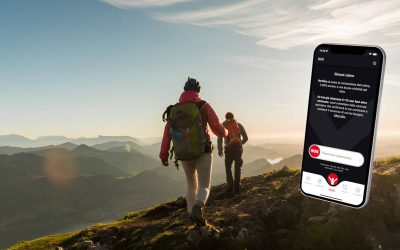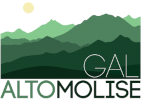| Itinerary | WAY OF THE RURAL CHURCHES - Itinerary 4: Agnone - Capracotta |
|---|---|
| Region | |
| Start point | |
| Difficulty | |
| Lenght | |
| Walking time | |
| Height difference | |
| Maximum quota |
Course description
This stage represents the most challenging of the entire Camino and ideally should be tackled in two comfortable hiking days. The first day could cover a 9-kilometer route steadily uphill, starting from Agnone and arriving at Guado Licia, the last point accessible via driveways. The second day, however, would involve a 10-kilometer route through mountain trails, reaching the highest elevation of the entire Camino at 1746 meters above sea level. The surrounding environment is clearly mountainous, with the vast valley of the Verrino Creek opening up behind us. In the first part of the journey, we will hike halfway up Mount Rocca l’Abate along dirt roads, surrounded by scattered farmhouses and small settlements, not far from the road that connects Agnone to Capracotta and the Abruzzo villages. On the way up, we will come across the beautiful country church of St. Onofrio, which offers breathtaking views of the valley. Continuing on a paved road, we will reach the Guado Licia Saddle, where it will be possible to rest and arrange a comfortable transfer to an accommodation facility. The second part of this stage, resuming from Guado Licia, will be entirely immersed in beautiful mountain trails, offering breathtaking views along the Sangro River Valley and the Verrino Stream Valley. We will cross the peaks of Mt. San Nicola and Mt. Campo and visit the charming little country church of Santa Lucia. Finally, we will reach Capracotta, one of the highest towns in the Apennines, thus completing this fascinating and adventurous stage of the Camino.
Useful information
Equipment and practical advice
EQUIPMENT
To optimize your equipment, carefully read information about the route to be taken and the weather and climate forecast. This could be a list of basic equipment:
backpack suitable for real needs – At least 1L of water (2 in warm months/hot drink in winter) – Hiking map – guide – sunglasses – multifunctional penknife – head flashlight – smartphone battery charger – powerbank – camera – insect repellent – first aid kit – rain jacket – airtight bag for valuables and clothing to keep dry in case of rain – bag for trash – anti inflammatory ointment – personal medication.
Bring some light and nutritious food such as dried fruits, chocolate bars, candy, honey (energy snack). Pack your lunch in advance or be sure to pass through a town in case you need supplies. Bring trekking poles that assist in pushing uphill and help with stability on rough trails. The presence of streams and wooded trails makes some trails impassable and very muddy in heavy rains. High, waterproof hiking shoes are essential here, along with good quality (breathable) socks, which should never be underestimated! Your clothing should not lack: Windbreaker/waterproof jacket; Hat; Gloves for low temperatures.
TIPS & BEHAVIOR
Although it may seem superfluous, we recall the need to behave properly and respectfully toward others and the environment, each person making his or her own contribution by bringing back with them what would harm the environment. The path can be walked all year round, but of course spring and autumn offer the best weather and landscape conditions. For many high stretches, periods of large winter snowfall should be avoided, and in the hottest summer period, water supply and travel time should be well calculated to move during the milder hours and stop during the hottest hours. The path is well marked with comfort flags and marker arrows.
Let’s not damage the plants, let’s remember that we walk through protected environments that need to be protected. We do not light fires. We keep dogs on a leash or harness, mandatory in protected areas. We do not abandon waste. We prevent all fire hazards. We also take into account that some trails may be challenging in bad weather conditions. We always follow the official trails and when in doubt turn back to the last marked trailhead. In Molise, free camping is prohibited in certain areas, therefore, facilities that can accommodate must be used.
CAI Classification of Routes
Italian Alpine Club classification of routes according to difficulty in hiking and cycling
EXCURSION SCOPE
T = Tourist
FEATURES
Routes on cart tracks, mule tracks or obvious paths that pose no uncertainties or problems of orientation, with modest inclines and moderate elevation changes.
SKILLS AND COMPETENCIES
Require basic hiking knowledge and physical fitness for walking.
EQUIPMENT
Appropriate clothing and footwear are still required.
E = Hiking
FEATURES
Routes that represent the majority of hiking routes, thus among the most varied in terms of natural environments. They take place on mule tracks, trails and sometimes tracks; on different terrain by geomorphological and vegetation context (e.g., pastures, undergrowth, debris, scree). They are generally marked and may have steep sections. Easy, unexposed rock passages can be encountered that require the use of hands for balance. Any exposed spots are usually protected. They can cross flat or shallowly sloping areas on residual snow.
SKILLS AND COMPETENCIES
They require sense of direction and hiking experience and adequate training.
EQUIPMENT
Suitable equipment with special regard to footwear is required.
EE= Experienced hikers
FEATURES
Nearly always marked routes that require ability to move along trails and tracks over impervious and/or treacherous terrain (steep and/or slippery slopes of grass, rocks or stony debris), often unstable and uneven. They may have exposed sections, traverses, ledges or rocky sections with slight technical difficulties and/or equipped, while via ferratas proper are excluded. They are developed on medium to steep slopes. Crossing sections on snow may be necessary, while all glacier routes are excluded.
SKILLS AND COMPETENCIES
Need excellent hiking experience, orienteering skills, knowledge of the characteristics of the mountain environment, sure-footedness and absence of vertigo, evaluative and decision-making skills as well as adequate physical fitness.
EQUIPMENT
Require appropriate equipment and gear for the planned itinerary.
EEA = Experienced hikers with equipment
A ferrata is defined as a route whose sections on rock are specially equipped with metal structures: cables, chains, ladders, pegs and stirrups, which facilitate and enable its progression. They provide for the use of personal protective equipment certified according to current regulations (harness, via ferrata kit and helmet) and adequate technical preparation. They are marked at the start by special signs and meet precise construction and regulatory criteria.
Points of interest
Abbey of Sant'Onofrio
Built in 1711 at the behest of Baron Joshua Bartolini, owner of the forest called precisely Montecastelbarone, the abbey dedicated to Saint Onofrio has preserved since 1722 the small statue of the anchorite saint whose name means ‘always happy.’ Related to the parish church of St. Anthony Abbot in the village, it was in ruins in the late 1800s and was renovated in the early next century. Devotion to the saint, who is invoked against fever, is very strong throughout the surrounding area, and there is a great demonstration of this on the occasion of the three feast days: June 11,12 and 13. The statue, brought into the village at the beginning of the festivities by car, is brought back to the abbey carried on the shoulders of the women. At one time the blessing of animals was imparted; since the 1960s the blessing has been imparted to the cars that queue up from the small church to return to the village. Very strong devotion remains in the large Agnonese community residing overseas.
Church of St. Lucy
In Capracotta, devotion to Saint Lucia is among the oldest and most heartfelt. On the contrary, the building of this chapel is very recent: in 1948 the saint appeared in a dream to a Capracottese man asking him to erect a small church, located on the slopes of Mount Campo, at a spring of water. Twenty-two citizens began operations to locate the spring, which was followed by construction work. The building was the result of a great community effort: with mules and donkeys all the materials were transported to build the small chapel. The entire townspeople worked on the construction, and to finish it they sold their grain harvest in 1950. Also the result of the town’s effort is the presence of the new statue dedicated to the saint at the heart of the celebrations held on the last Sunday in August. The feast in honor of the Syracuse saint, preceded by a triduum, is inaugurated by the rite of distributing blessed cooked wheat, a symbol of prosperity and union. The statue is taken to the village in a procession at sunset on Saturday and brought back to the chapel on Sunday at the end of the celebrations.
3D Map
The linked App is not related to the website, but provides additional convenience in using the presented content. Its use is voluntary. If the app is not yet installed on your device, you will be redirected to the corresponding App Store.
Agnone – Capracotta
(km 16.94)
Itinerary 4
Departure: Agnone
Arrival: Capracotta
Distance: 16.94 kilometers
Travel time: 5h 30′
Difficulty: Experienced Excursionists
Height difference: +1300 -750
34% asphalt – 66% dirt roads
Cyclability: Yes (partly 8 km) – from Agnone toward Capracotta is cyclable to Guado Liscia
Recommended Period: Spring, summer, autumn
GPX files: Download
![]()
![]()
![]()
![]()
Frame or click the QR code and open the Web App
It should be noted that the routes may include sections where vehicular traffic is concurrent.
Photographs
Other Itineraries
![]() I1: Civitanova del Sannio – Poggio Sannita
I1: Civitanova del Sannio – Poggio Sannita![]() I2: Poggio Sannita – Belmonte del Sannio
I2: Poggio Sannita – Belmonte del Sannio![]() I3: Belmonte del Sannio – Agnone
I3: Belmonte del Sannio – Agnone![]() I4: Agnone – Capracotta
I4: Agnone – Capracotta![]() I5: Capracotta – Pescopennataro
I5: Capracotta – Pescopennataro![]() I6: Pescopennataro – Sant’Angelo del Pesco
I6: Pescopennataro – Sant’Angelo del Pesco![]() I7: Sant’Angelo del Pesco – Castel del Giudice
I7: Sant’Angelo del Pesco – Castel del Giudice![]() I8: Castel del Giudice – Capracotta
I8: Castel del Giudice – Capracotta![]() I9: Poggio Sannita – Castelverrino
I9: Poggio Sannita – Castelverrino![]() I10: Castelverrino – Agnone
I10: Castelverrino – Agnone
Highlights
Mountain safety: GeoResQ, the free app that connects you with rescuers in an emergency
GeoResQ, www.georesq.it, is a service run by the National Alpine and Speleological Rescue Corps, promoted by the Italian Alpine Club with the support of the Ministry of Tourism. The free downloadableapplication dedicated to mountain activities can directly send a call...
Concert by the CAI Choir of Lanciano in the Cloister of San Francesco di Agnone
AgnonEstate 2024 Appointments. On Friday, August 2 , at 9:30 p.m., in the beautiful setting of the Cloister of San Francesco, the Italian Alpine Club (CAI) Choir of Lanciano will perform a brilliant and sophisticated repertoire betweenclassic Alpine songs and Abruzzo...
Mountain safety: GeoResQ, the free app that connects you with rescuers in an emergency
GeoResQ, www.georesq.it, is a service run by the National Alpine and Speleological Rescue Corps, promoted by the Italian Alpine Club with the support of the Ministry of Tourism. The free downloadableapplication dedicated to mountain activities can directly send a call...
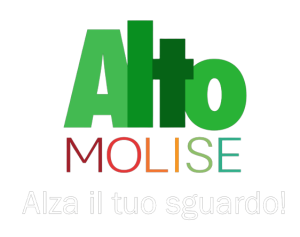

The “Walk of the Country Churches” is an outdoor trail of about 90 kilometers connecting 9 historical centers e 15 small churches scattered throughout the territory of Agnone, Belmonte del Sannio , Capracotta , Castel del Giudice, Castelverrino, Civitanova del Sannio, Pescopennataro, Poggio Sannita e Sant’Angelo del Pesco.
© The Way Of The Country Churches | Project | Credit | Privacy Policy | Cookie Policy | Contact
INITIATIVE FUNDED BY THE FEASR – European Agricultural Fund for Rural Development – PSR Molise Region 2014 – 2020

